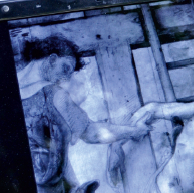
Doutoramento em Astrofísica Computacional
Thermal and dynamical evolution of interstelar medium in a section of the Galactic disk
Gervásio Jorge Anela

Orientação: Miguel Ângelo Pignatelli de Avillez
The interstelar medium is mainly composed of gas in the form of molecular and atomic hydrogen involving thermal and dynamic processes. Hot stars produce ultraviolet radiation that ionizes hydrogen giving rise to a fluorescent glow. The voids between stars are filled by interstellar dust composed of small particles of grains with radius variyng between 10 9 to 10 7 m that represent 1% of the mass of the interstellar medium (ISM).
The dynamic processes that occur in the ISM are due to interactions between supernovas and the ISM. The increase in temperature and in gas pressure results in the expansion of the gas, where the energy resultant from the explosions is converted to kinetic energy of the gas. The expansion of HII regions and planetary nebulae generates shock waves that result from the HII regions immersion in the cold gas at low temperature. Stellar winds are the result of the acceleration from OB stars with velocities of (v _ 1000 km /s) and finally the collisions from diffuse nebulae generate the dissipation of the kinetic energy in the form of heat through shock waves.
Based on the observations of the ISM, we carried out studies that present results of termal and dynamic evolution in the mediplane of the galaxy to the ray of the sun, using computational techniques with several models. The explanation of the behavior of the interstellar medium is based on the study of gas density, stellar density and gas temperature, which can be performed in time intervals, distances, areas and volumes of gas columns. The energies and processes involved by the electrons assume a relevant role in the thermal and dynamic mechanism of the gas in the ISM. In this thesis, the gas in the interstellar medium is explained as a dynamic and thermal component.
Keywords: Interstellar, Galactic, Dynamical, Thermal, Section




